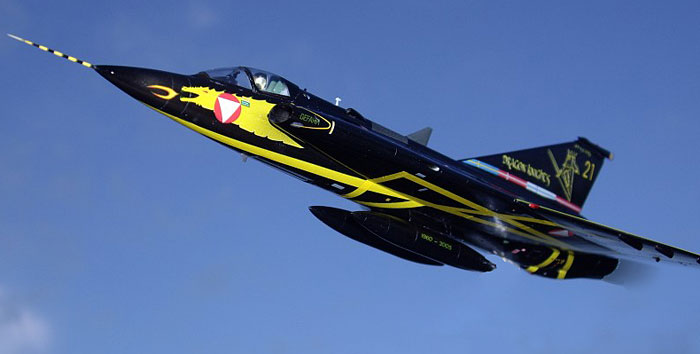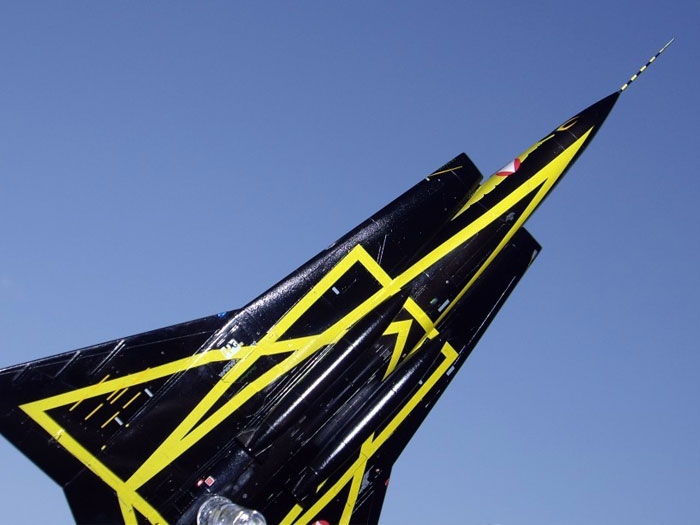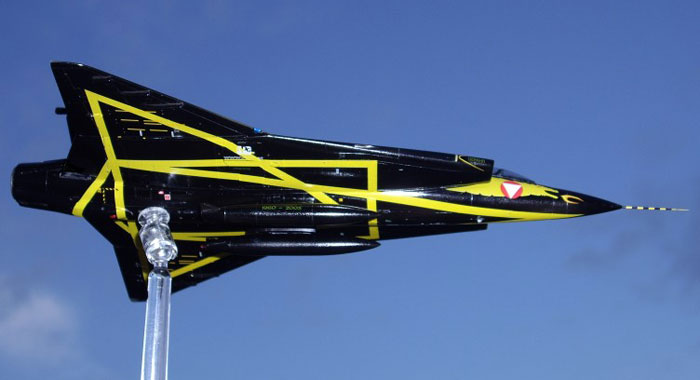|
Hasegawa's 1/72 scale
Saab J-35Ö Mk.2
Draken
by Pierpaolo Maglio
|
 |
|
Saab J-35Ö Mk.2 Draken |

Hasegawa's 1/72 scale Draken is available online from Squadron.com
The Saab Draken has been my favourite plane since I was a kid. Those
unique shapes were sexy and futuristic even if the aircraft was designed
during the '50s, that is why I have built lots of Draken kits in almost
all scales: Airfix and Heller in 72, Arii and Tamiya in 1/100 and I'm
still waiting for a 48 scale kit that will make me the happier modeller
in the world.
By the way the best Draken kit ever made, so far, is the Hasegawa one in
72 scale. I build several of them in the past and you can find pictures
in my web photo album here:
http://album.foto.alice.it/modelsfromitaly
Last year saw the sad demise of this aviation legend and the Austrian
Air Force made a special colour all black Draken to celebrate the event.
Hasegawa was quick to offer a special box with two kit inside: one is
the very famous "Ostarichi" that flew for many years in a red-white-red
colour scheme, and the second one is the Black Knight.

By the way to build an Austrian Draken the Hasegawa kit is not enough.
The Japanese model is a J- 35F and lacks the modifications added to the
Austrian machines.
Österreichische Luftstreitskräfte bought from Sweden 24 old Saab J-35D.
These aircraft before delivering to Austria got just a few modifications
the most visible one was the introduction of a new more rounded canopy,
the same used on J-35F/J.
The Austrian Draken were called Saab 35Ö and during the early '80s flew
armed with just two guns, since Austria was banned from using missiles
since the end of WWII.
By the way during the long civil war in ex-Yugoslavia Austrian skies
become more and more dangerous so Österreichische Luftstreitskräfte was
able to upgrade its interceptor with AIM-9J Sidewinders missiles and
Radar Warning Receiver systems. Missiles, under wing pylons and
launchers again come from Sweden while RWR systems were token from
Danish Air Force Drakens that were retired in those years.
The modernized and armed Draken in Österreichische Luftstreitskräfte
become Saab 35Ö Mk.II.
To build an accurate kit you will need to scratch build those RWR
antennas on the tail and around the exhaust, but those pieces are really
small one and I think is better to use the resin bits produced and sold
by IPMS Austria.
IPMS Austria kit gives you the whole fuselage end as a solid resin part
and this piece is much more detailed than the original one given by
Hasegawa.
Another resin part in the IPMS Austria kit is the correct fuselage hump
of the J-35D model, quite different from the J-35F/J that you can find
in the Hasegawa kit. Fitting of the resin hump is almost perfect but you
will need to add 1mm piece of plastcard to the back of it since the
resin part is a bit too short and would not fit the canopy without that
simple addition.
The resin hump also has a small PE parts that you need to add to it to
represent some scoops that gave air to the avionics. Fitting is a little
tricky since the PE set is a little too big, but trimming and cutting it
is all you need to do to achieve a perfect fitting.
I choose not to spend too much time in detailing the canopy since I
choose to me this plane in flight attitude because the most spectacular
part of it is on the bottom.

So the cockpit just got a gray-green paint and the decals from the kit
box; a pilot (from Hasegawa F-16) was added later.
The most difficult part of the building process come later: closing the
landing gear doors. Some of them (especially the small ones in the resin
tail) would not fit in closed position so you will need time and
patience to add putty and plastcard to make them perfectly closed.
The rest of the kit is very simple to build; you only need to spend a
bit of time in polishing it well when finished since the glossy black
scheme would show any flaws.
To paint the kit I used Tamiya glossy Black thinned with GSI Creos Mr.
thinner. That way the colour becomes easier to spry.
Then was the time for the decals.
Hasegawa gives you two very thin and well printed sheets, by the way the
yellow is not that deep and, especially the smallest one, let the back
underside to show trough. That is why I choose to apply two set of
decal, one above the other, on all small yellow drawings (the Knight on
the tail, the numbers on the fuel tanks etc..).
Hasegawa decals are so thing that you can barely see that there are two
one above the other.
By the way Hasegawa forgot to print a piece of the shield and many gray
stencils that are around the wings and fuselage, especially on the
bottom.
For the gray stencils I cut some pieces of old decals from the spare box
(a walkway from Fujimi A-4) the missed horizontal yellow band, just in
front of the fuel tanks, was cut from the second Hasegawa decal sheet.

Than I washed the kit in warm water to remove any glue from the decals
and sprayed a coat of Future to protect the decals and restore the high
gloss finish of the model.
Final details were added at this stage: the pitot tube in the kit is
horrible and unsuitable, I made a new one from a needle worked with a
motor tool to made it conical; then added the anti collision light from
small CMK resin bits, one on top of the fin and the other under the
fuselage were Hasegawa tells you to put just a red decal.
The T shape antenna on the hump was added as the last one since I
managed to loose 3 of them!!! (Anybody can spare one or more for my next
Drakens?).
When the model was finally finished I made a hole in the belly to put it
on the Hasegawa clear stand, it was from the time I made my last
Matchbox kit (26 years) that I didn't made a model in flight but I must
say that the Draken looks much better in flight than on ground, isn't?
Click the thumbnails below to view larger images:
Model, Images and Text Copyright ©
2006 by Pierpaolo Maglio
Page Created 31 October, 2006
Last Updated
30 October, 2006
Back to
HyperScale Main Page |
Home
| What's New |
Features |
Gallery |
Reviews |
Reference |
Forum |
Search